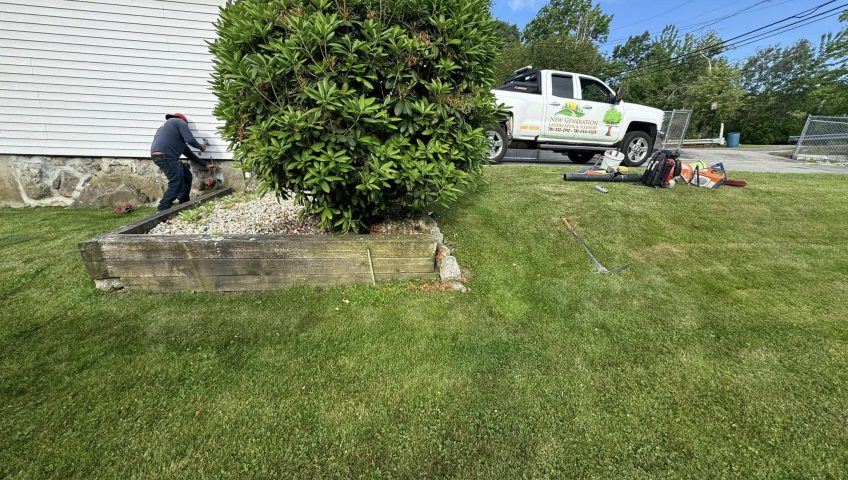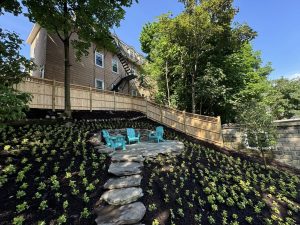Creating a stunning landscape that thrives with minimal water is no longer just an environmental necessity—it’s a smart investment in your property’s future. Drought resistant landscaping combines aesthetic appeal with sustainability, offering homeowners the perfect solution for beautiful yards that conserve water and reduce maintenance costs. Whether you’re dealing with water restrictions, rising utility bills, or simply want a more eco-friendly outdoor space, implementing smart design strategies can transform your property into a resilient oasis.
When planning your water-wise garden transformation, partnering with experienced professionals makes all the difference. New Generation Landscaping & Fence in Peabody, MA, brings years of expertise in creating sustainable outdoor spaces that withstand New England’s changing climate conditions. Their comprehensive approach to landscape design ensures your drought-resistant garden not only survives but thrives year after year.
Understanding Drought Resistant Landscaping Principles
Successful water-wise landscaping relies on three core principles: proper plant selection, efficient water management, and strategic design planning. The foundation starts with understanding your local climate, soil conditions, and sun exposure patterns throughout your property.
Native and adapted plants form the backbone of any sustainable landscape design. These species have evolved to thrive in local conditions, requiring significantly less water once established. Additionally, grouping plants with similar water needs creates efficient irrigation zones, preventing overwatering of drought-tolerant species while ensuring adequate moisture for plants that need it.
Soil preparation plays a crucial role in water retention and plant health. Improving drainage in heavy clay soils prevents root rot, while adding organic matter to sandy soils increases water-holding capacity. Professional landscaping services can assess your soil conditions and recommend appropriate amendments for optimal plant performance.
15 Low-Water Plants for Stunning Landscapes
Perennial Powerhouses
1. Lavender (Lavandula species) This fragrant herb offers purple spikes of flowers and silvery foliage that thrives in hot, dry conditions. Lavender attracts beneficial pollinators while providing natural aromatherapy for your outdoor spaces.
2. Black-Eyed Susan (Rudbeckia fulgida) Bright yellow daisy-like flowers bloom from summer through fall, creating cheerful color with minimal water requirements. These native perennials self-seed readily, expanding your garden naturally.
3. Sedum (Sedum spectabile) Succulent foliage stores water efficiently, while late-season pink flower clusters provide autumn interest. Various sedum species offer different textures and colors for diverse design options.
4. Ornamental Grasses (Miscanthus, Festuca, Pennisetum) These provide movement, texture, and year-round structure with minimal water needs. Ornamental grasses create natural privacy screens and add architectural interest to landscape designs.
Shrubs for Structure and Color
5. Barberry (Berberis species) Thorny shrubs with colorful foliage ranging from green to deep red provide security and beauty. These hardy plants tolerate poor soils and drought conditions exceptionally well.
6. Juniper (Juniperus species) Evergreen conifers offer year-round color and structure in various shapes and sizes. From ground-covering varieties to upright specimens, junipers adapt to challenging growing conditions.
7. Spirea (Spiraea species) Delicate flowers in spring complement attractive foliage that may turn brilliant colors in fall. These deciduous shrubs require minimal care once established in appropriate locations.
Proper landscape design and installation ensures these plants are positioned for maximum success with minimal water input.
Trees for Shade and Structure
8. Eastern Red Cedar (Juniperus virginiana) Native evergreen trees provide year-round screening and wildlife habitat with exceptional drought tolerance. These trees adapt to various soil conditions and require virtually no supplemental watering.
9. Honey Locust (Gleditsia triacanthos) Filtered shade from delicate compound leaves allows understory plants to thrive while the tree withstands drought conditions. Thornless varieties eliminate maintenance concerns.
(Beautiful Drought Resistant Landscape Design with Native Plants
Ground Covers and Fillers
10. Creeping Thyme (Thymus serpyllum) Aromatic ground cover produces tiny flowers and withstands foot traffic while requiring minimal water. This herb releases fragrance when walked upon, creating sensory garden experiences.
11. Lamb’s Ear (Stachys byzantina) Soft, silvery foliage creates textural interest while conserving moisture through fuzzy leaf surfaces. Purple flower spikes add vertical interest in early summer.
12. Catmint (Nepeta species) Fragrant foliage and blue-purple flowers bloom repeatedly throughout the growing season with minimal care. These plants repel certain pests while attracting beneficial insects.
Specialty Plants for Unique Appeal
13. Yucca (Yucca filamentosa) Architectural sword-like leaves and dramatic white flower spikes create bold focal points in drought-resistant gardens. These plants thrive in poor soils with excellent drainage.
14. Russian Sage (Perovskia atriplicifolia) Silvery foliage and purple flower spikes create an airy, ethereal appearance throughout the growing season. This perennial combines beautifully with ornamental grasses and other drought-tolerant plants.
15. Coneflower (Echinacea purpurea) Native wildflowers attract butterflies and birds while requiring minimal water once established. Purple, pink, and white varieties offer color options for diverse design schemes.
Quality sod installation can complement these plantings by establishing drought-tolerant grass varieties in high-use areas.
💡 Expert Tip: Plant Establishment Success
Even drought-resistant plants need consistent watering during their first growing season. Provide 1-2 inches of water weekly until roots establish, then gradually reduce watering frequency. Deep, infrequent watering encourages deep root development for better drought tolerance.
Design Strategies for Water-Wise Landscapes
Zoning for Efficiency
Create distinct zones based on water requirements, sun exposure, and intended use. Place thirsty plants near irrigation sources and in naturally moist areas, while positioning drought-tolerant species in hot, dry locations. This strategy, called hydrozoning, maximizes water efficiency while ensuring plant success.
Hardscaping Integration
Incorporate permeable materials like gravel pathways, stone patios, and mulched areas to reduce lawn coverage while adding functional beauty. These elements require no watering while providing structure and reducing overall landscape maintenance requirements.
Mulching for Moisture Retention
Apply 2-3 inches of organic mulch around plants to retain soil moisture, suppress weeds, and moderate soil temperature. Wood chips, shredded bark, and compost improve soil structure as they decompose, creating better growing conditions for drought-resistant plants.
Professional fencing installation can complement water-wise landscaping by defining spaces and providing structure for climbing drought-tolerant vines.
Cost-Effective Implementation Strategies
Phased Installation Approach
Transform your landscape gradually by focusing on one area at a time. Start with high-visibility areas like front entries, then expand to larger spaces as budget allows. This approach spreads costs over time while allowing you to learn what works best in your specific conditions.
Budget-Friendly Plant Sources
Consider starting plants from seed, purchasing smaller specimens, or propagating from friends’ gardens. Many drought-resistant perennials divide easily, allowing you to expand plantings without significant additional costs.
DIY vs. Professional Installation
While many homeowners can plant individual specimens, larger projects benefit from professional expertise. Commercial landscaping professionals understand soil preparation, proper spacing, and design principles that ensure long-term success.
| Plant Category | Water Needs | Maintenance Level | Best Use |
|---|---|---|---|
| Native Perennials | Very Low | Low | Mixed borders, naturalized areas |
| Ornamental Grasses | Very Low | Very Low | Screening, texture, winter interest |
| Drought-Tolerant Shrubs | Low | Low | Foundation plantings, hedging |
| Succulents | Very Low | Very Low | Rock gardens, containers |
| Native Trees | Low | Medium | Shade, screening, wildlife habitat |
Maintenance Tips for Long-Term Success
Seasonal Care Requirements
Spring maintenance includes removing winter debris, dividing overcrowded perennials, and refreshing mulch layers. Summer care focuses on monitoring for pest issues and providing supplemental water during extended dry periods only when necessary.
Fall preparation involves cutting back spent perennials, planting new additions, and applying winter mulch protection. Winter requires minimal intervention, allowing plants to enter dormancy naturally.
Key Success Factors:
- Proper plant selection based on your specific microclimate conditions
- Adequate soil preparation with appropriate drainage improvements
- Strategic watering during establishment followed by gradual reduction
- Regular monitoring for pest and disease issues
- Annual maintenance including pruning and dividing as needed
Common Mistakes to Avoid
Overwatering remains the most frequent error in drought-resistant landscaping. Many homeowners continue regular irrigation schedules even after plants establish, preventing proper drought adaptation. Additionally, choosing plants based solely on appearance rather than suitability for local conditions leads to disappointing results and increased maintenance requirements.
Inadequate soil preparation, particularly poor drainage in clay soils, causes root problems even in drought-tolerant species. Skipping mulch application or using inappropriate materials reduces moisture retention and weed suppression benefits.
FAQ Section
Q: How long does it take for drought-resistant plants to establish?
A: Most drought-resistant perennials and shrubs require one full growing season to establish strong root systems. Trees may need 2-3 years to become fully drought tolerant. During establishment, provide consistent watering, then gradually reduce frequency to encourage deep root development.
Q: Can I still have colorful flowers with drought-resistant landscaping?
A: Absolutely! Many drought-tolerant plants offer spectacular blooms. Native wildflowers, lavender, coneflowers, and ornamental grasses provide seasonal color while conserving water. The key is selecting plants that naturally thrive in your local climate conditions.
Q: What’s the difference between drought-resistant and drought-tolerant plants?
A: Drought-resistant plants actively prevent water loss through specialized features like waxy leaves or water storage capabilities. Drought-tolerant plants can survive extended dry periods but may not have specific water-conserving adaptations. Both work well in water-wise landscapes.
Q: How much can I save on water bills with drought-resistant landscaping?
A: Homeowners typically reduce landscape water usage by 30-60% compared to traditional turf-heavy designs. Actual savings depend on local water rates, property size, and previous irrigation habits. The investment often pays for itself within 3-5 years through reduced utility costs.
Conclusion
Transforming your property with drought resistant landscaping creates lasting value while supporting environmental sustainability. These 15 carefully selected plants and proven design strategies provide the foundation for beautiful, low-maintenance outdoor spaces that thrive with minimal water input. By implementing proper planning, plant selection, and installation techniques, you’ll enjoy reduced maintenance costs, increased property value, and the satisfaction of contributing to water conservation efforts.
Ready to Transform Your Landscape?
Create your dream drought-resistant landscape with professional expertise and proven results. Our team specializes in sustainable design solutions that save water and enhance property value.
New Generation Landscaping & Fence – Serving Peabody, MA and surrounding areas

